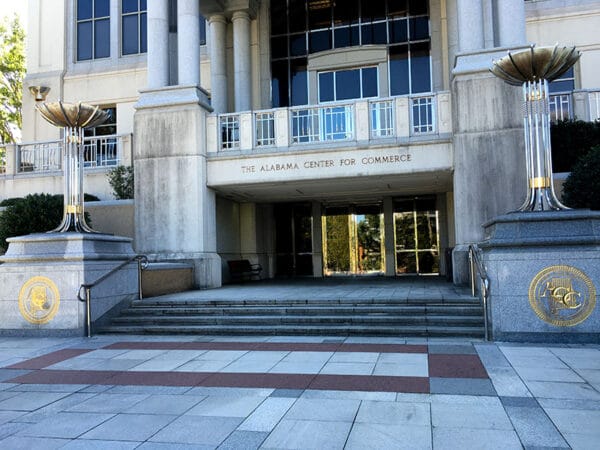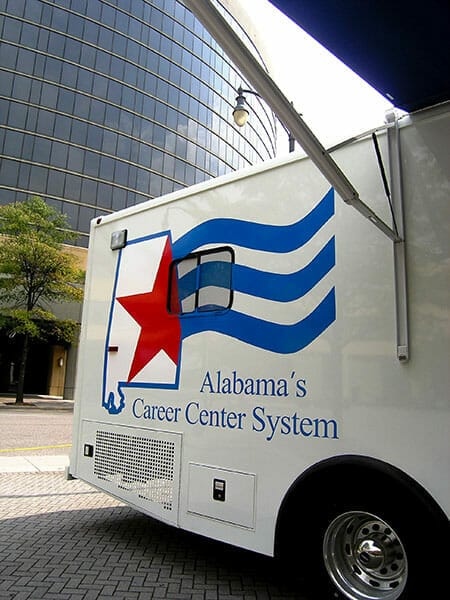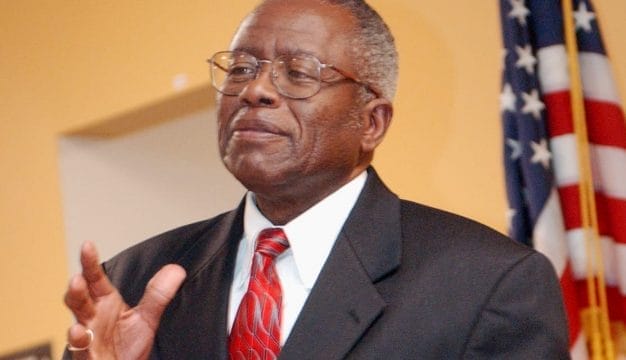Alabama Department of Economic and Community Affairs
 ADECA Headquarters
The Alabama Department of Economic and Community Affairs (ADECA) was created in 1983 to consolidate under one agency many of the federally funded development programs administered by the state. The overriding goal was to increase efficiency and improve oversight of these programs. The department supports Alabama communities by providing funds, surplus government property, information, training, and oversight to local governments, community organizations, businesses, and individuals throughout the state. ADECA’s largest role, however, is distributing federal funds.
ADECA Headquarters
The Alabama Department of Economic and Community Affairs (ADECA) was created in 1983 to consolidate under one agency many of the federally funded development programs administered by the state. The overriding goal was to increase efficiency and improve oversight of these programs. The department supports Alabama communities by providing funds, surplus government property, information, training, and oversight to local governments, community organizations, businesses, and individuals throughout the state. ADECA’s largest role, however, is distributing federal funds.
History
Prior to ADECA’s establishment, federal funds and programs were administered by the Office of State Planning and Federal Programs, the Alabama Department of Energy, the Alabama Law Enforcement Planning Agency, the Office of Highway and Traffic Safety, and the Office of Employment and Training. Beginning in 1969, the Alabama Development Office (ADO), the present-day Alabama Department of Commerce, managed some of the federal programs now under ADECA. By 1980, the Alabama Legislature transferred the planning and federal program tasks of the ADO to the new Office of State Planning and Federal Programs. Soon after, the legislature took additional steps to consolidate and streamline the state’s administration of federal programs.
In February 1983, legislation establishing ADECA was passed and signed into law by Gov. George Wallace on March 1. Originally known as the Department of Economic and Community Affairs, with the acronym DECA, Alabama was added to the name shortly after its creation. ADECA was placed within the Office of the Governor under that individual’s direct supervision. Bill Rushton, who was previously head of the Office of State Planning and Federal Programs, was named the first director by Wallace. A ten-member legislative oversight commission was created to provide additional supervision and evaluate the agency’s work.
Often referred to as an umbrella agency, ADECA has since been given more responsibility. In 1984, the Surplus Property Division was added and in 1991, the Office of Water Resources was established by an executive order issued by Gov. Guy Hunt. Also that year, ADECA moved from its original facilities located off Norman Bridge Road in Montgomery, Montgomery County, to its current location within the Alabama Center for Commerce at 401 Adams Avenue in downtown Montgomery. The Alabama Water Resources Act was passed in 1993, making the Office of Water Resources a permanent fixture within ADECA. Two outdoor recreation programs were also added to ADECA during the 1990s.
Organizational Structure and Activities
 ADECA Mobile Classroom
ADECA is overseen by a director who is appointed by the governor and serves on the governor’s cabinet. The director is responsible for appointing chiefs to each of five divisions who also are approved by the governor. The agency divisions are comprised of: Community and Economic Development; Energy; Law Enforcement and Traffic Safety; Office of Water Resources, and Surplus Property. Each division administers programs. In addition, the agency has six sections which provide administrative support and oversight to the divisions. These offices fulfil necessary behind-the-scenes roles such as legal counsel , auditing, human resources, and information services.
ADECA Mobile Classroom
ADECA is overseen by a director who is appointed by the governor and serves on the governor’s cabinet. The director is responsible for appointing chiefs to each of five divisions who also are approved by the governor. The agency divisions are comprised of: Community and Economic Development; Energy; Law Enforcement and Traffic Safety; Office of Water Resources, and Surplus Property. Each division administers programs. In addition, the agency has six sections which provide administrative support and oversight to the divisions. These offices fulfil necessary behind-the-scenes roles such as legal counsel , auditing, human resources, and information services.
The department’s divisions are organized by purpose and by federal funding agency. The Community and Economic Development division, for example, administers federal programs related to community development, community services, and recreation. They are largely funded by the U.S. Departments of Housing and Urban Development, Health and Human Services, Interior, and Transportation. One of the most notable programs in this division is the Community Development Block Grant (CDBG) Program, which awards funds to local communities for infrastructure improvements, job creation, disaster recovery, and other community development activities. ADECA has funded more than 4,000 community development projects, awarding more than one billion dollars in CDBG funds.
The Energy division works with the U.S. Department of Energy and other federal agencies to improve energy efficiency and reduce energy consumption in Alabama. The Law Enforcement and Traffic Safety division distributes federal grant funds, largely from the National Highway Traffic Safety Administration and the U.S. Department of Justice, to law enforcement and traffic safety programs, victim services, and juvenile justice. The Office of Water Resources provides planning and oversight for Alabama’s water resources and serves as the state’s liaison with the Federal Emergency Management Agency (FEMA) and other related federal agencies. Some of its main tasks relate to planning and managing floodplains and drought in Alabama. The Surplus Property division distributes surplus state and federal and property. Part of its role is operating the Law Enforcement Support Office (LESO), through which excess military equipment is distributed to law enforcement agencies in Alabama. The agency also implements related state programs and provides resource planning to local governments, non-governmental organizations, private businesses, and individuals in Alabama.
Overall, ADECA receives more than 90 percent of its funding from numerous federal agencies. The agency’s divisions then distribute what amounts to hundreds of millions of federal dollars to local governments, organizations, businesses, and individuals throughout Alabama each year. Additional contributions come from the State General Fund. It is one of the state’s primary operating funds from which the legislature appropriates money to ADECA each year to meet federal matching requirements for grants and to cover administrative and operational costs of ADECA programs. ADECA programs are not focused on one specific area of policy implementation; they are extremely diverse and potentially affect every Alabamian and Alabama community.
Challenges and Accomplishments
The agency has improved efficiency and oversight to ensure that funds are distributed and used lawfully and ethically. But there have been instances in which the agency has not been successful. In 2003, Nicholas Bailey, a former acting director of ADECA, and two other individuals (Montgomery businessman and consultant Clayton “Lanny” Young Jr. and Montgomery architect William “Curtis” Kirsch) pleaded guilty to conspiracy to commit bribery in connection with federal programs associated with his oversight of the department. Bailey, a close associate of then-Gov. Don Siegelman, was also involved in the bribery case against Siegelman. In 2009, former Alabama lawmaker Edward McClain and former pastor Samuel Pettagrue were convicted on a variety of charges stemming from McClain improperly steering ADECA funds to a nonprofit organization run by Pettagrue. Another challenge has been sufficient funding. The agency has experienced decreased funding from the federal government and also struggles with inconsistent funding from the state. Due to federal efforts to reduce the national debt, this problem may continue to worsen.
Despite these challenges, ADECA has had notable accomplishments. Since the agency’s creation, the state has reported reductions in administrative costs and improvements to its compliance monitoring framework associated with federal programs. ADECA programs have led to significant job creation in Alabama and helped low-income residents become more self-sufficient. ADECA has funded projects that have increased tourism opportunities in Alabama communities. In addition, the agency has applied for and received federal funding to help storm recovery efforts.
Moving forward, ADECA will likely continue to face difficulties associated with funding reductions. Many Alabama cities and counties struggle with tight budgets, and communities throughout the state have unmet needs that local governments cannot afford to address. The necessity for federal and state dollars distributed by ADECA is likely to continue. Grant awards are and will probably remain scarce, increasing the need to ensure that funding decisions are fair and transparent.



